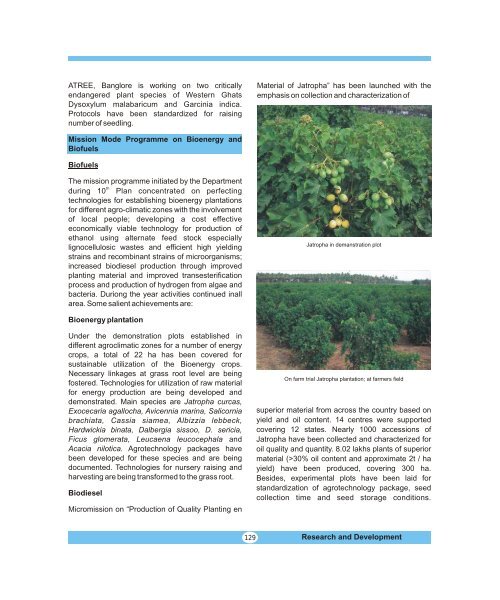ANNUAL REPORT - Department of Biotechnology
ANNUAL REPORT - Department of Biotechnology
ANNUAL REPORT - Department of Biotechnology
You also want an ePaper? Increase the reach of your titles
YUMPU automatically turns print PDFs into web optimized ePapers that Google loves.
ATREE, Banglore is working on two critically<br />
endangered plant species <strong>of</strong> Western Ghats<br />
Dysoxylum malabaricum and Garcinia indica.<br />
Protocols have been standardized for raising<br />
number <strong>of</strong> seedling.<br />
Mission Mode Programme on Bioenergy and<br />
Bi<strong>of</strong>uels<br />
Bi<strong>of</strong>uels<br />
The mission programme initiated by the <strong>Department</strong><br />
th<br />
during 10 Plan concentrated on perfecting<br />
technologies for establishing bioenergy plantations<br />
for different agro-climatic zones with the involvement<br />
<strong>of</strong> local people; developing a cost effective<br />
economically viable technology for production <strong>of</strong><br />
ethanol using alternate feed stock especially<br />
lignocellulosic wastes and efficient high yielding<br />
strains and recombinant strains <strong>of</strong> microorganisms;<br />
increased biodiesel production through improved<br />
planting material and improved transesterification<br />
process and production <strong>of</strong> hydrogen from algae and<br />
bacteria. Duriong the year activities continued inall<br />
area. Some salient achievements are:<br />
Bioenergy plantation<br />
Under the demonstration plots established in<br />
different agroclimatic zones for a number <strong>of</strong> energy<br />
crops, a total <strong>of</strong> 22 ha has been covered for<br />
sustainable utilization <strong>of</strong> the Bioenergy crops.<br />
Necessary linkages at grass root level are being<br />
fostered. Technologies for utilization <strong>of</strong> raw material<br />
for energy production are being developed and<br />
demonstrated. Main species are Jatropha curcas,<br />
Exocecaria agallocha, Avicennia marina, Salicornia<br />
brachiata, Cassia siamea, Albizzia lebbeck,<br />
Hardwickia binata, Dalbergia sissoo, D. sericia,<br />
Ficus glomerata, Leucaena leucocephala and<br />
Acacia nilotica. Agrotechnology packages have<br />
been developed for these species and are being<br />
documented. Technologies for nursery raising and<br />
harvesting are being transformed to the grass root.<br />
Biodiesel<br />
Micromission on “Production <strong>of</strong> Quality Planting en<br />
129<br />
Material <strong>of</strong> Jatropha” has been launched with the<br />
emphasis on collection and characterization <strong>of</strong><br />
Jatropha in demanstration plot<br />
On farm trial Jatropha plantation; at farmers field<br />
superior material from across the country based on<br />
yield and oil content. 14 centres were supported<br />
covering 12 states. Nearly 1000 accessions <strong>of</strong><br />
Jatropha have been collected and characterized for<br />
oil quality and quantity. 8.02 lakhs plants <strong>of</strong> superior<br />
material (>30% oil content and approximate 2t / ha<br />
yield) have been produced, covering 300 ha.<br />
Besides, experimental plots have been laid for<br />
standardization <strong>of</strong> agrotechnology package, seed<br />
collection time and seed storage conditions.<br />
Research and Development

















